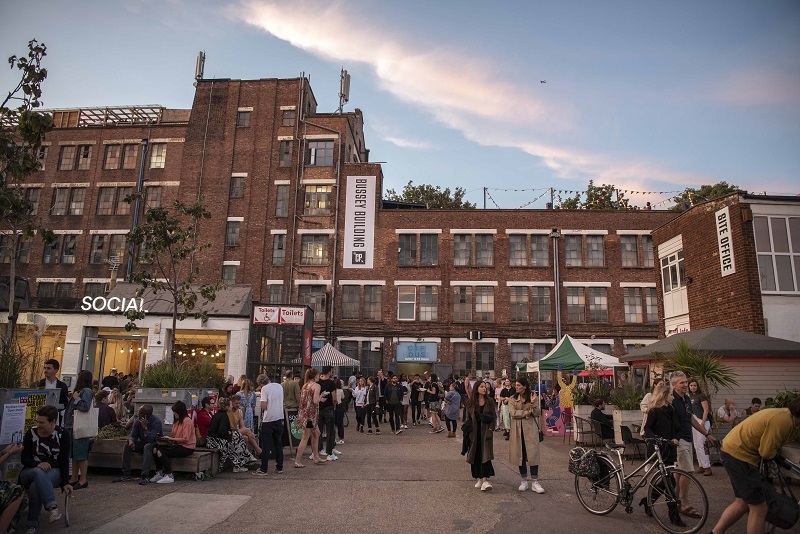Copeland Park, Peckham - Copeland Park & Bussey Building

Where is the project located - please enter full address and postcode?
133 Copeland Road, Peckham, SE15 3SN
Who is the developer/client of the project?
Copeland
Describe the context of this project and how it contributes positively to the wider place in 250 words max. and please upload an image of the project in its wider context or a drawing that best situates the project in its location.
Copeland Park and Bussey Building [CPBB] is Peckham’s cultural quarter, hosting a calendar of events whilst supporting the creative industries of Southwark and South London. A diverse community of artists, co-working space, small business incubation, bars & restaurants, and fitness ventures; it also offers mixed usage spaces for artistic and cultural events, including a gallery, warehouse and rooftops.
Copeland Park’s buildings comprise single-storey warehouses and revitalised gallery spaces. The Bussey Building dates from the late 19th century and is a brick industrial building, built as a factory by manufacturer George Bussey. CPBB was saved from being turned into a tram depot by Southwark Council and TfL in 2009.
Environmental sustainability has been realised by avoiding the demolition of historic, aging buildings; giving these buildings a longer life; and subsequently delivering social and economic impact via job creation and cultural community opportunities.
We have set the bar for a grassroots, community-led creative prototype; realising potential in the Peckham arts scene before it was widely recognised. We opened low-cost artists studios in the iconic Bussey Building and curated a range of creative micro and small businesses in Copeland Park.
Today we have over 60 studios housing artists and a multitude of creative businesses, plus galleries, a rooftop cinema, yoga studio, architects, record and fashion shops, and we host c.60 events annually. This archetype has been replicated locally; e.g. Peckham Levels, Market Peckham; but CPBB is an authentic small business ecosystem unrivalled in London with a long track history to prove this.
How does this project make use of an existing structure, place or building in a creative way? 250 words max. Please attach an image of the project that supports your statement.
CPBB is now a significant cultural, creative hub, providing 56,000ft²+ of artists studios, x4 galleries, events spaces, radio stations, and recording studios. The project has celebrated retention over demolition, enhancing urban life. More than a studio provider, we incubate creative businesses; 73% of tenants are arts/culture, providing a public platform for artists.
Openness & visibility to the public as a lively mixed-use culture hub is the route to long-term sustainability, supporting 700 jobs across 120 microbusinesses onsite and making economic and cultural impact.
Copeland Gallery, our high-profile exhibition space, hosts art shows, markets and community events. Besides wide-ranging national/international exhibitions, Copeland Gallery exhibits the degree shows of the UK’s top art schools; Camberwell, Swansea, Kingston, Goldsmith’s, UAL, Brighton, Newcastle, and UCA.
Unit 8 is our 11,500 ft² warehouse for events. Spring 2021 film/photography shoots include: comedy show ‘Sliced’, Dazed magazine with Burberry, Danny Boyle’s upcoming film about the Sex Pistols. Events in the past 18 months include: Independent Ceramics Market, DIY Art Market, plus a 3 month residency for independent cinema Pop Up Screens.
The buildings are also a canvas; examples of notable street art on site, attracting visitors: Shaping Peckham mural by artist & printmaker Katrina Russell-Adams; Crank & the Yard gyms wrapped in artist INSA’s rainbow pattern; Dan Kitchener’s freehand spray painted artwork on Kanpai’s walls (the UK’s 1st sake brewery); Thierry Noir’s distinctive heads painted on the brick of Bussey Alley; and Japanese graffiti art collective THA’s mural for London Mural Festival.
How will this project continue to evolve or enable future flexibility and adaptation? 250 words max. Please attach an image of the project that supports your statement.
Our business philosophy of providing multi-use, flexible spaces for SMEs within the Arts and Cultural industries provides a constant flexibility to adaptation.
By targeting creatives, startups and growing businesses with short leases we allow for continual evolution, thereby protecting future flexibility. Development of the spaces is conscientious in order to maintain the established enterprises whilst allowing new opportunities to grow. This philosophy empowers us to adapt to ever-changing market conditions.
Innovative ideas have utilised the buildings’ existing features. Prime examples are: the rooftop cinema, the UK’s first Sake brewery, and examples of notable street art.
Curating a cross-section of small businesses and giving them the opportunity to grow, we nurture a collaborative ecosystem - the tenants here work together - that’s authentic and sustainable. This is supported by our offers of shared meeting rooms and galleries at affordable rates to trial and experiment ideas.
In April 2020 a start-up requested space to produce hand sanitizer provisions to the NHS and care homes. We offered space on a service charge only basis for them to establish the business and support their charitable mission. This business has now evolved into a retail shop.
An area hit hardest due to the pandemic was our micro-business retail arcade, Holdrons Arcade, which saw over 70% of businesses vacate. Using this as an opportunity, we have refurbished the arcade; exposing heritage features of the Art Deco building. We are marketing to young start-up arts businesses for pop-ups to trial projects, acting as an incubation hub.
Please share any data or figures that support how your entry has made a positive environmental, economic and social impact on the wider place. You may also attach an additional image or document to support your entry.
Social Impact
In 2019, we assisted and donated space to:
Black Women Rising Exhibition, creating cancer awareness amongst the BAME community
We Are Bloco, a fundraising gig for youth performance group Kinetika Bloco
Mixed Raced Faces, a photo exhibition of mixed heritage Londoners
UK Vegans of Colour market - Black History Month
Cultural and Economic Impact
Our new initiative supporting emerging artists is a residency programme; a month’s free studio and a solo exhibition as well we have allocated 4 weeks free gallery use to diverse groups; South Asian Heritage Month Exhibition and Black History Month.
We established the annual Peckham Festival (since 2016); a cultural carnival featuring open studios, performances, a Community Hub, food, drink, drawing 18,000 visitors in 2019.
Our dynamic offering features in ‘What’s On’ press listings including Time Out, Evening Standard, Metro, Londonist; drawing 500,000+ visitors annually from across London and has contributed to Peckham’s perception in the press as “London’s Coolest Neighbourhood” and a district to visit to “get cultured” (Time Out, September 2019)
Environmental Impact
Working with TfL, we plan to revamp the waste and recycling management; reducing traffic and pollution in the local area whilst also providing an expanded set of recycling options for our tenants. This will reduce our waste carbon footprint by 75%.
Supporting 700 local jobs and 120 micro businesses locally reduces central London commuting.
Introduction of bike racks has increased the use of cycles as a means of transportation, reducing emissions on site and in the neighbourhood.
-
Early bird entry deadline: 15 December 2023
-
Final entry deadline: 25 January 2024
-
Festival of Pineapples: 15-19 April 2024
-
Awards party, London: May 2024
© The Pineapples - Tweak Ltd. 124 City Road, London, EC1V 2NX. Tel: 020 3326 7238
